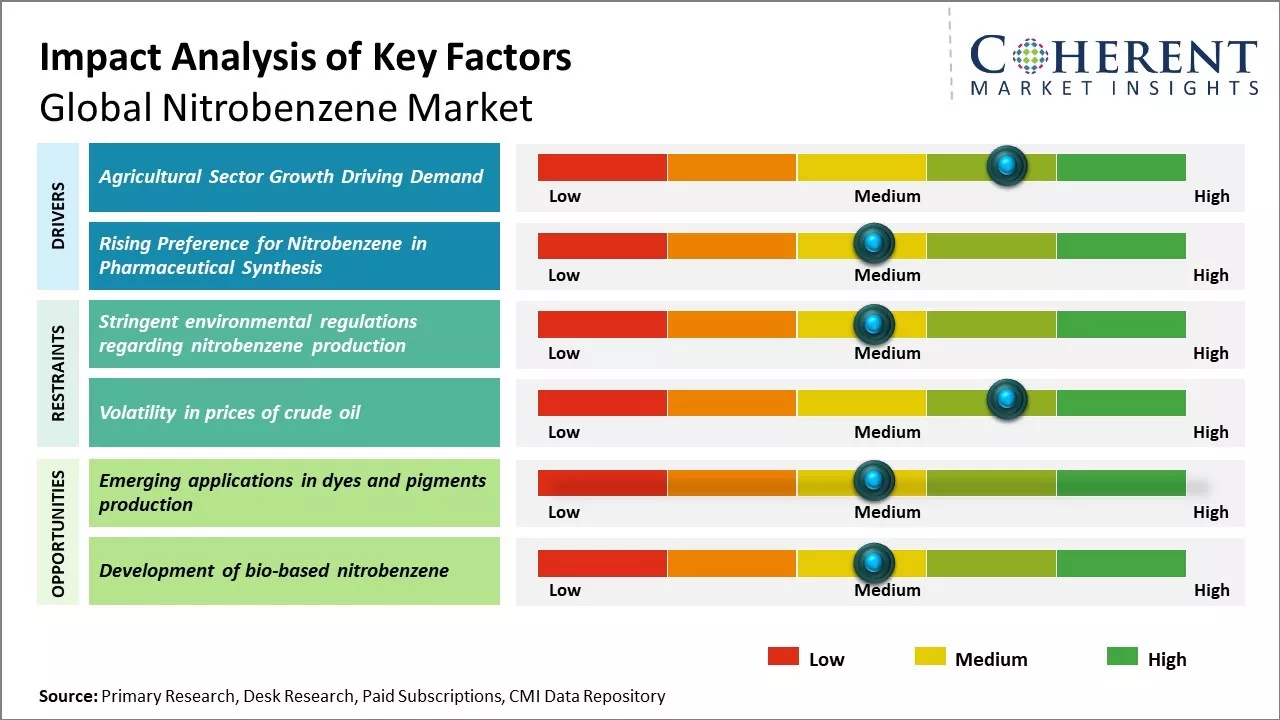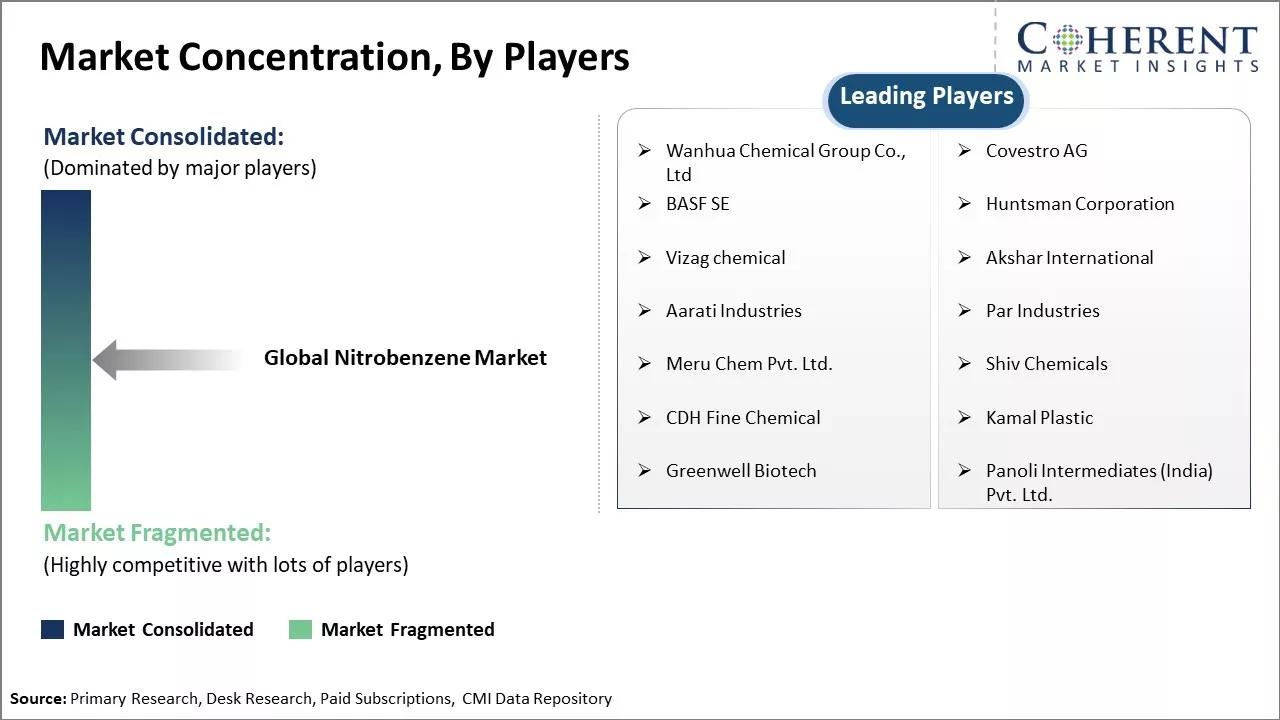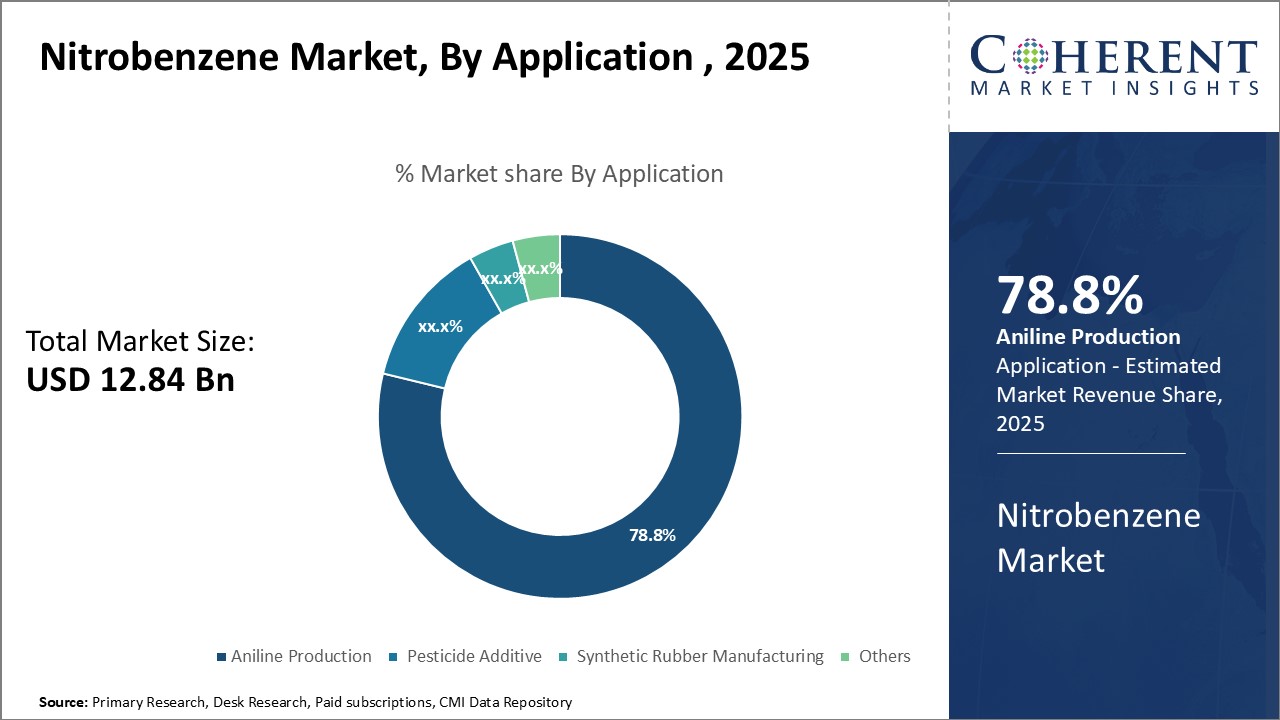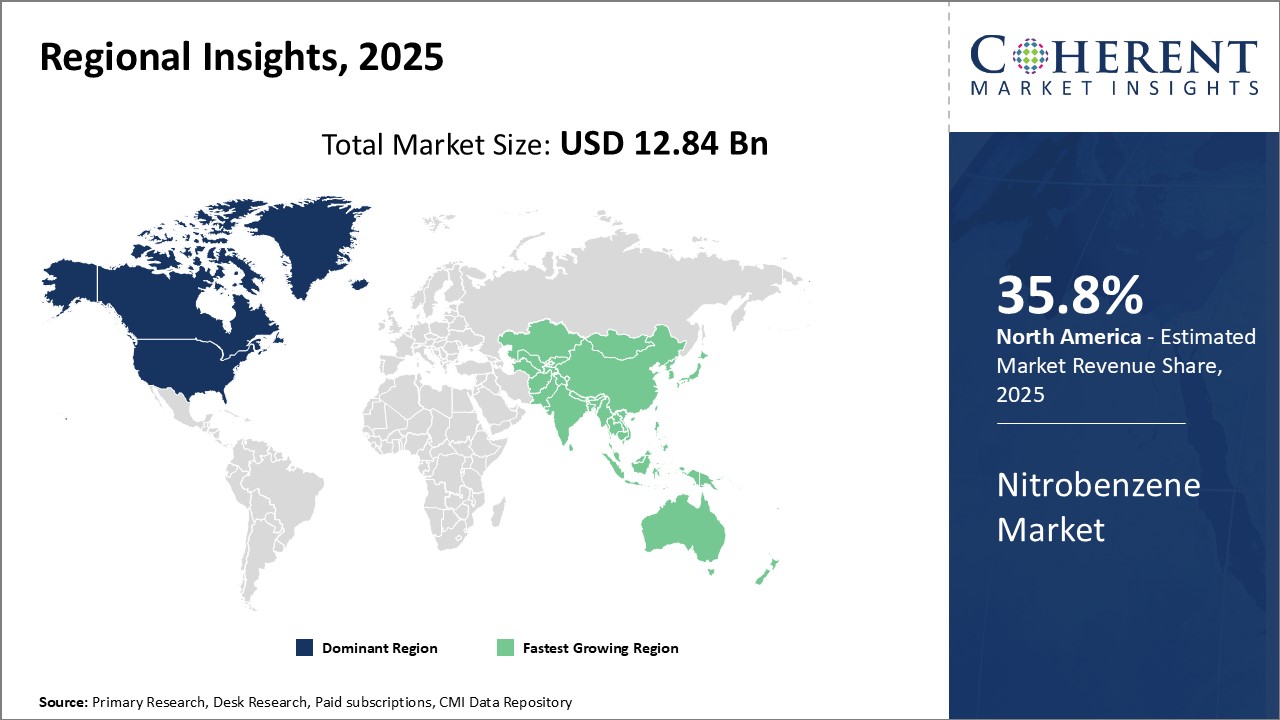Nitrobenzene Market Size and Trends
The nitrobenzene market is estimated to be valued at USD 12.84 Bn in 2025 and is expected to reach USD 18.95 Bn by 2032, exhibiting a compound annual growth rate (CAGR) of 5.7% from 2025 to 2032.

Discover market dynamics shaping the industry: Download Free Sample
The global nitrobenzene market is expected to witness moderate growth over the forecast period. Increased demand from the chemical intermediates and end-use industries such as construction, automotive along with rising automotive production will drive the nitrobenzene market growth. Further, growing agriculture sector leading to rising demand for aniline, a key derivative is expected to propel the nitrobenzene demand. However, inventory pressure from China amid oversupply and fluctuations in crude oil prices remains a concern. Nevertheless, growing infrastructure development and car sales mainly in Asia Pacific is likely to offer new opportunities for market growth in the coming years.
Agricultural Sector Growth is Driving Demand
The global agricultural sector has seen steady growth over the past few decades, fueled by rising population and income levels across major developing economies. Nitrobenzene serves as a key intermediate in the production of aniline, which is further used to manufacture agricultural chemicals such as herbicides, pesticides, and fungicides. With food demand expected to increase substantially in the coming years to meet the needs of billions more consumers, agricultural yields must grow in tandem. This will mandate greater use of agrochemicals to boost and protect crop output from pests and adverse climate conditions.
Being an essential chemical building block, increased nitrobenzene consumption is likely to follow the expanding agrochemical industry. Leading crop protection majors have been investing heavily in developing markets to make vital formulations more accessible and affordable for smallholder farmers. Intensifying agricultural mechanization is also creating the demand for highly effective synthetic inputs. Meanwhile, multi-national companies have been developing bio-based and eco-friendly alternatives to reduce environmental footprint, playing to sustainability goals of governments and growing health concerns of consumers. However, these novel solutions will still rely on conventional intermediates like nitrobenzene for quite some time due to technological and cost constraints.
Overall, the interlinked forces of socio-economic development, policy support for food security, and agro-industry R&D present a strong growth outlook for the global agricultural sector. As nitrobenzene acts as a backbone material for agrochemical production, consistent gains in agriculture can be expected to drive its consumption volumes considerably over the next decade or more.
Market Concentration and Competitive Landscape

Get actionable strategies to beat competition: Download Free Sample
Rising Preference for Nitrobenzene in Pharmaceutical Synthesis
The pharmaceutical industry has emerged as a major end-use sector for nitrobenzene in recent years. It is widely employed as a critical intermediate for manufacturing important bulk drugs and active pharmaceutical ingredients (APIs). A number of factors contribute to the increasing relevance of nitrobenzene in pharmaceutical synthesis routes. To start with, population aging trends coupled with rapid economic development have enlarged the patient bases that require various medications for chronic diseases. Additionally, stringent environmental mandates on manufacturing processes are favoring the use of greener and eco-friendly solvents like nitrobenzene.
Key Takeaways from Analyst:
The nitrobenzene market continues to be driven by the demand from the aniline production sector. As aniline acts as a key intermediate in the manufacturing of rubber chemicals, dyes, and pharmaceuticals, steady growth in end-use industries will reliably support nitrobenzene consumption in the coming years. However, increasingly stringent environmental regulations pose a potential restraint, as nitrobenzene is classified as toxic and carcinogenic.
Major producers will need to invest in improved safety and emissions equipment to remain compliant. Another opportunity for market growth lies in Asia Pacific. With China remaining the dominant consumer globally, other developing Asian countries like India and Southeast Asian nations are industrializing rapidly. As disposable incomes rise across the region, the demand for various downstream products utilizing nitrobenzene intermediates will ascend.
Regulations in Europe and North America focusing on benzene substitution may stimulate innovation in production methods. Alternatively sourced nitration routes could alleviate environmental pressures while stabilizing supply chains. The agricultural sector is one area primed for further market penetration as well. Nitrobenzene sees usage as a fungicide and its derived nitrophenol products have applications in pest control. As concerns regarding food security increase, demand from agrochemical end-markets is poised to expand steadily.
Market Challenges: Stringent environmental regulations regarding nitrobenzene production
Stringent environmental regulations regarding nitrobenzene production have significantly restrained the growth of the global nitrobenzene market in recent years. Nitrobenzene is classified as hazardous by various environmental agencies due to its toxicity and potential negative impact on the environment if not handled properly. It is considered a carcinogen that can contaminate air and water sources if released through improper waste disposal methods during manufacturing. More stringent emission norms pertaining to nitrobenzene production have been enacted by environmental watchdogs like the European Union and EPA in the United States since 2020. This has forced nitrobenzene producers to invest heavily in upgrading their waste treatment facilities and installing emissions control equipment to meet the threshold limits prescribed for safe release of effluents. Significantly higher capital and operational expenditures are now required to attain compliance with regulatory standards. Such increased compliance burden has reduced the profit margins of nitrobenzene producers. Some small-scale manufacturers have even shut down operations due to difficulties in meeting stricter norms, thereby restricting the expansion of global production capacity over the past couple of years.
Market Opportunities: Emerging applications in dyes and pigments production
The production of dyes and pigments is one of the largest end-use applications of nitrobenzene globally. Nitrobenzene acts as an important intermediate in the manufacture of various azo dyes, which find widespread applications across many industries like textiles, paints, printing inks, plastics, leather, and cosmetics. Azo dyes alone account for over half of the global dye market. With rising demand for these end-use industries, nitrobenzene consumption for dye production is expected to steadily grow in the coming years.

Discover high revenue pocket segments and roadmap to it: Download Free Sample
Insights by Application: Dominance of Aniline Production in the Application Segment
In terms of application, aniline production is expected to contribute 78.8% share of the nitrobenzene market in 2025, owing to its wide use as a key intermediate in manufacturing dyes and drugs. Nitrobenzene serves as an important raw material for aniline production, which is further used across many end-use industries.
The dye industry has emerged as a major consumer of aniline, utilizing it for manufacturing various azo, vat, and sulfur dyes. Rising demand for these dyes from the thriving textile sector is positively impacting the sales of aniline. On the other hand, aniline derivatives such as sulfanilamide and methylenebis are commonly used as crucial active pharmaceutical ingredients (APIs) in several medicines. Growing generic drug consumption in the healthcare industry ensures steady revenue streams for nitrobenzene producers.
Moreover, aniline is a base chemical employed for rubber vulcanization process. The surging rubber exports from China and India have augmented the need for aniline and by extension nitrobenzene in these countries. Many agrochemical formulators also use aniline for producing fungicides, herbicides, and insecticides. Therefore, the prospering agricultural sector worldwide acts as a driver for the aniline production segment.
Insights by End-use Sector: widespread applications of products
End-use sector is expected to account for 42.8% share in the nitrobenzene market in 2025, owing to the widespread applications of products like aniline formaldehyde resin. Aniline formaldehyde resin, commonly known as amine-based hardener, is a crucial adhesive agent utilized for plywood, particle board, and medium-density fiber board manufacturing.
Rapid infrastructure growth and building construction activities across developing economies have considerably increased the demand for engineered wood products where aniline formaldehyde resin serves as a key binding agent. Furthermore, the surging repairs and renovations of existing structures in urbanizing regions present ongoing requirement for wood adhesives.
In addition, aniline is used in the production of certain paints and varnishes employed for coating, painting, and protecting surfaces of concrete structures, metallic structures, etc. Thus, the ongoing construction of commercial buildings, housing units, and industrial facilities fosters the consistent consumption of paints and coatings, thereby driving the nitrobenzene market growth.
Regional Insights

Need a Different Region or Segment? Download Free Sample
North America has been the dominant region in the global nitrobenzene market for many years. The region is expected to account for 35.8% share of the market in 2025. The well-established chemical industry and presence of major end-use industries such as construction, pharmaceuticals, and agrochemicals have been the key growth drivers. The availability of raw materials and low transportation costs have also contributed to the leading position of the region. Several manufacturing facilities are located within or close to major consumption hubs, allowing the easy availability of nitrobenzene for both domestic usage and exports. Many global players also have their headquarters and key production sites in the U.S., helping maintain market supremacy. However, pricing pressures due to overcapacity have prevented high growth rates in the region over the past five years.
The Asia Pacific region has emerged as the fastest growing market for nitrobenzene globally. Rapid industrialization and infrastructure development across developing Asian countries have boosted demand from the construction industry tremendously. Being a major global pharmaceutical producer, the expanding healthcare sector is also propelling the regional market. Further, as agriculture forms the backbone of economies such as India and China, strong nitrobenzene consumption from agrochemical producers has distinguished the region. Wide availability of labor and resources provides a conducive environment for manufacturing facilities. Many international players have established or expanded sites to leverage Asia Pacific's vibrant market and lower costs. This has made the region an important hub for both local consumption and exports to other developing markets. Favorable government regulations and initiatives to bolster chemicals production are anticipated to sustain the momentum. With its large population base and rising standards of living, Asia Pacific appears well-positioned to take over global leadership in the long run.
Market Report Scope
Nitrobenzene Market Report Coverage
| Report Coverage | Details | ||
|---|---|---|---|
| Base Year: | 2024 | Market Size in 2025: | USD 12.84 Bn |
| Historical Data for: | 2020 To 2024 | Forecast Period: | 2025 To 2032 |
| Forecast Period 2025 to 2032 CAGR: | 5.7% | 2032 Value Projection: | USD 18.95 Bn |
| Geographies covered: |
|
||
| Segments covered: |
|
||
| Companies covered: |
Wanhua Chemical Group Co., Ltd, Covestro AG, BASF SE, Huntsman Corporation, Vizag chemical, Akshar International, Aarati Industries, Par Industries, Meru Chem Pvt. Ltd., Shiv Chemicals, CDH Fine Chemical, Kamal Plastic, Greenwell Biotech, and Panoli Intermediates (India) Pvt. Ltd. |
||
| Growth Drivers: |
|
||
| Restraints & Challenges: |
|
||
Uncover macros and micros vetted on 75+ parameters: Get instant access to report
Nitrobenzene Industry News
- In 2023 Wanhua's BorsodChem inaugurated Site IV and its new production units, as part of which the company has invested in the construction of nitrobenzene and aniline production facilities in the new site
- In 2022, researchers at the University of Glasgow announced that they created a new process of aniline production that works at room temperature and pressure. The breakthrough process uses protons and electrons created by the electrolysis of water to drive the process of reducing nitrobenzene to anilines.
*Definition: The nitrobenzene market is primarily focused on the manufacturing and distribution of nitrobenzene, an important organic compound that is widely used in the production of aniline, which is further used to manufacture polyurethanes, synthetic rubber, and pesticides. Nitrobenzene is an intermediate reagent for the industrial synthesis of azo dyes, pharmaceuticals, and pesticides. It is a clear to pale yellow liquid that is soluble in organic solvents. The major end-use industries driving the nitrobenzene market are construction, automotive, furniture, manufacturing of polyurethane foams, and agriculture.
Market Segmentation
- Application Insights (Revenue, USD Bn, 2020 - 2032)
- Aniline Production
- Pesticide Additive
- Synthetic Rubber Manufacturing
- Others (Paint Solvent, etc.)
- End-use Insights (Revenue, USD Bn, 2020 - 2032)
- Construction
- Agriculture
- Pharmaceutical
- Others (Automotive, etc.)
- Regional Insights (Revenue, USD Bn, 2020 - 2032)
- North America
- U.S.
- Canada
- Latin America
- Brazil
- Argentina
- Mexico
- Rest of Latin America
- Europe
- Germany
- U.K.
- Spain
- France
- Italy
- Russia
- Rest of Europe
- Asia Pacific
- China
- India
- Japan
- Australia
- South Korea
- ASEAN
- Rest of Asia Pacific
- Middle East & Africa
- GCC Countries
- Israel
- Rest of Middle East & Africa
- North America
- Key Players Insights
- Wanhua Chemical Group Co., Ltd
- Covestro AG
- BASF SE
- Huntsman Corporation
- Vizag chemical
- Akshar International
- Aarati Industries
- Par Industries
- Meru Chem Pvt. Ltd.
- Shiv Chemicals
- CDH Fine Chemical
- Kamal Plastic
- Greenwell Biotech
- Panoli Intermediates (India) Pvt. Ltd.
Share
Share
About Author
Yash Doshi is a Senior Management Consultant. He has 12+ years of experience in conducting research and handling consulting projects across verticals in APAC, EMEA, and the Americas.
He brings strong acumen in helping chemical companies navigate complex challenges and identify growth opportunities. He has deep expertise across the chemicals value chain, including commodity, specialty and fine chemicals, plastics and polymers, and petrochemicals. Yash is a sought-after speaker at industry conferences and contributes to various publications on topics related commodity, specialty and fine chemicals, plastics and polymers, and petrochemicals.
Missing comfort of reading report in your local language? Find your preferred language :
Transform your Strategy with Exclusive Trending Reports :
Frequently Asked Questions
EXISTING CLIENTELE
Joining thousands of companies around the world committed to making the Excellent Business Solutions.
View All Our Clients
